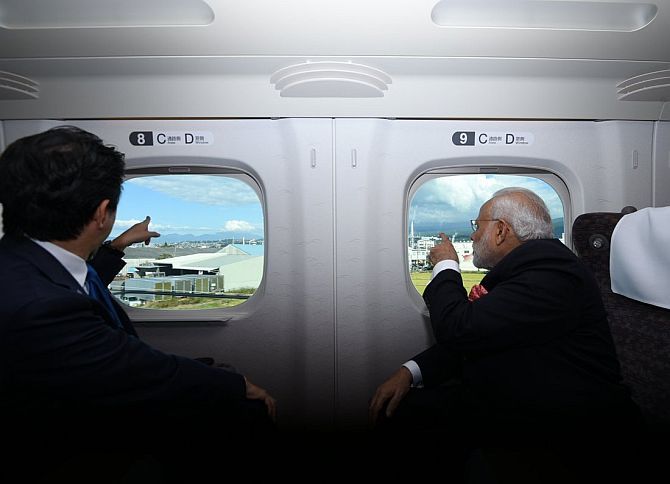The vanity project, of absolutely no use to most Indians, will suck money that could be used for health and education, says Aakar Patel.
(This column is being repromoted as Prime Minister Narendra Modi and Japanese Prime Minister Shinzo Abe launched the bullet train project from Ahmedabad on Thursday. The column was first published on November 14, 2016.)

There are over 200 trains going from Ahmedabad to Mumbai. The first one leaves just after midnight and the last one leaves just before.
So there are trains going through the day to cover the 524 km distance.
There is an airport in Ahmedabad from where there are about 10 daily flights to Mumbai.
Ahmedabad and Mumbai are part of the Golden Quadrilateral highway network with six lane expressways on which travel by road is as fast as travel by train. It is possibly the best connected route in India.
I am writing this because Prime Minister Narendra Modi finalised a deal for a bullet train with Japanese leader Shinzo Abe. The train will run from Ahmedabad to Mumbai and design work will begin in a few days.
The project will cost around Rs 1 lakh crore.
The cost is officially said to be Rs 97,636 crore, but reports said a Rs 10,000 crore additional cost may be incurred.
To put the figure in perspective, we should know that it is three times the size of India's health budget.
India is a country where 38% of all children are malnourished and stunted at the age of 2.
This means they will have less physical and intellectual capacity than healthy children and they will never be able to lead a fulfilling life.
The bullet train will cost more than we spend annually on the education budget of India.
Again, we have some of the lowest literacy rates in the world. And we have a very poor quality of literacy, about which I have written before.
The other aspect is that even within the transport industry, our investment does not seem to be made with any sort of attention to the poor and those most in need.
In 2005, the BJP governments in Madhya Pradesh and Chhattisgarh shut down the state transport bus system. The reason was that the buses did not make a profit, but how are the poor expected to travel?
Of course this profitability is not expected of the bullet train and other projects because, like the giant statues of Vallabhbhai Patel and Chhatrapati Shivaji coming up in Ahmedabad and Mumbai, these are projects that will add to national pride.
One justification for the bullet train is that it will also service two other Gujarati cities on the route, Vadodara, which is 110 km from Ahmedabad and Surat, which is another 120 km down the road.
Vadodara also has many flights to Mumbai. I used to regularly visit my parents in Surat because there was a single flight from Bangalore, but now I cannot because there is no flight.
On November 6, 2014, a SpiceJet Boeing had an accident at Surat airport. A report said the jet 'hit a buffalo that had strayed on to the runway because of a hole in the airport';s boundary wall. The engine of the Boeing 737 aircraft was severely damaged by the hit and the plane stopped. The buffalo was killed.'
The report added that the 'civil aviation ministry has ordered two inquiries, by the director general of civil aviation and the Airports Authority of India. A perimeter security review of airports across the country has been ordered' and 'Minister Ashok Gajapati Raju held a 2-hour meeting this morning and ordered, sources say, that all airports should be secured by a concrete boundary, not fencing or brick walls.'
The government seems to be keen on spending money for the transport of the rich, on the assumption that this will grow the economy and ultimately benefit the nation.
If so it will help to have a functional and safe airport in Surat that connects it to the rest of the world, rather than a bullet train taking one only to and from Mumbai.
This buffalo episode highlights India's inability to secure and sanitise spaces. That additional cost of Rs 10,000 crore (Rs 100 billion) referred to earlier is for an elevated corridor, meaning the bullet train will run high above the chaos of India.
It will be a vanity project, sucking money that could be used for health and education. And of absolutely no use to the vast majority of Indians.
It will be of no particular use even to those living in and between Ahmedabad and Mumbai, already the best connected part of India.
Aakar Patel is Executive Director, Amnesty International India. The views expressed here are his own.
- You can read Aakar's earlier columns here.
IMAGE: Prime Ministers Narendra Modi and Shinzo Abe aboard the Shinkansen bullet train. Photograph: Ministry of External Affairs










